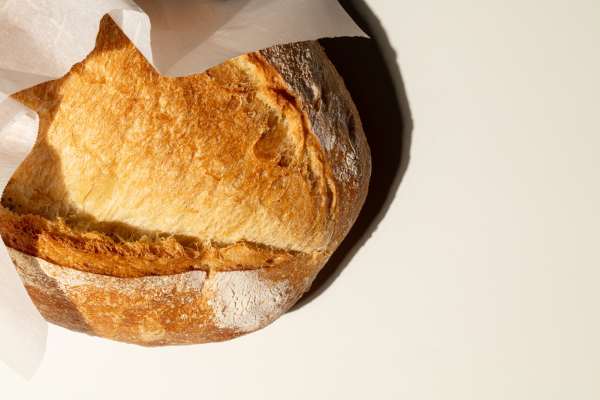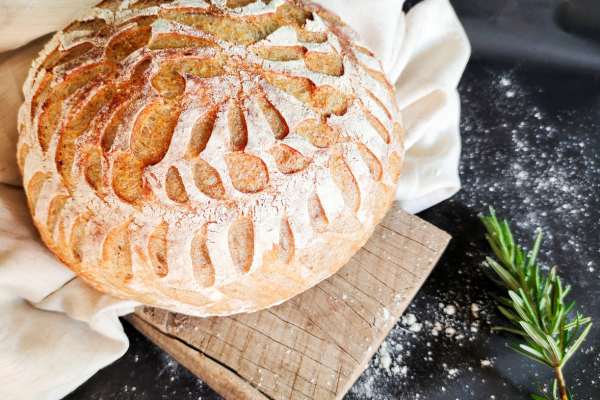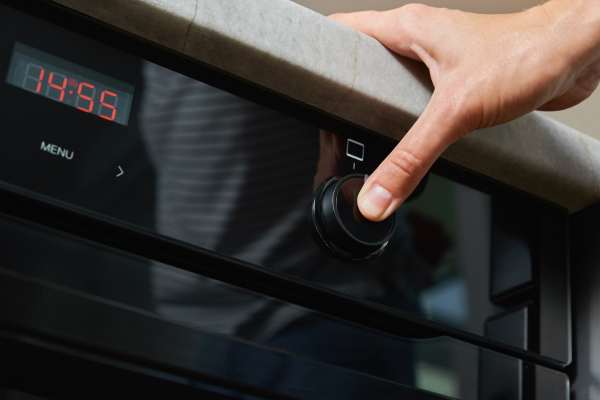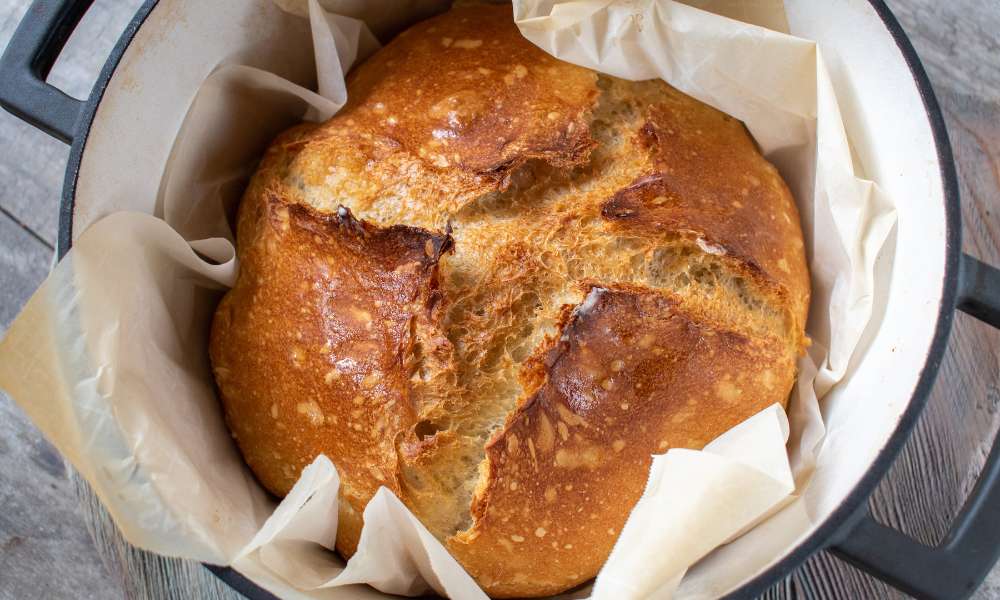Baking sourdough bread is an art, and understanding why cook sourdough in Dutch oven can take your loaves to the next level. A Dutch oven creates an ideal baking environment by trapping steam, ensuring a perfectly crispy crust and a tender, airy interior. Its thick walls and even heat distribution help the dough rise beautifully while enhancing flavor development. Whether you’re a novice or an experienced baker, using a Dutch oven simplifies the process and guarantees professional-quality results at home. In this article, we’ll explore the key benefits, techniques, and tips for baking sourdough in a Dutch oven, helping you achieve bakery-worthy bread every time.
How a Dutch Oven Creates the Perfect Baking Environment

A Dutch oven creates the perfect baking environment by mimicking the conditions of a professional steam oven. Its thick, heavy walls retain and distribute heat evenly, ensuring the bread cooks consistently from crust to crumb. The tight-fitting lid traps steam released from the dough during baking, which keeps the surface moist, allowing the bread to expand fully before forming a golden, crispy crust. This unique environment is ideal for sourdough, as it enhances texture, flavor, and appearance. Additionally, the consistent heat control prevents burning and helps maintain the bread’s natural hydration. For home bakers seeking exceptional results, the Dutch oven is an invaluable tool.
The Role of Steam in Baking Sourdough in a Dutch Oven

Steam plays a crucial role in baking sourdough in a Dutch oven, significantly impacting the bread’s texture and appearance. When the dough is exposed to steam during the initial baking phase, it delays the formation of the crust, allowing the bread to expand fully for a light, airy crumb. This process also enhances the Maillard reaction, giving the loaf a beautifully caramelized, golden-brown crust. The Dutch oven’s sealed environment naturally traps steam, making it an ideal tool for creating professional-quality sourdough at home. By understanding and utilizing steam effectively, bakers can achieve the perfect balance of crustiness and softness in their sourdough loaves.
Achieving Crispy Crusts: Dutch Oven vs. Other Methods
When it comes to achieving a perfectly crispy crust, a Dutch oven stands out compared to other baking methods. Its design traps steam during the initial baking phase, which is crucial for creating a shiny, crackly exterior. Other methods often fail to replicate this steam effect, leading to uneven crusts. The thick walls of a Dutch oven ensure even heat distribution, which promotes consistent browning and a golden finish. By controlling moisture and temperature effectively, it provides professional-quality results that can be challenging to achieve with standard baking sheets or pans. This makes it a go-to tool for bakers aiming for a superior crust.
Maintaining Consistent Heat for Better Sourdough Results
Maintaining consistent heat is essential for achieving perfect sourdough results. Uneven temperature can lead to improperly baked bread, affecting both texture and flavor. A Dutch oven provides a controlled environment, distributing heat evenly and trapping steam to ensure consistent baking. Preheating the Dutch oven is crucial, as it allows the dough to rise properly and develop a crispy crust. Avoid opening the lid frequently during baking, as this can release heat and steam, disrupting the process. By focusing on maintaining stable temperatures, you can create sourdough with a soft, airy crumb and golden crust, making your bread both visually appealing and delicious.
Why a Dutch Oven is Beginner-Friendly for Sourdough Bakers

A Dutch oven is an excellent tool for beginner sourdough bakers because it simplifies the bread-making process. Its ability to trap steam creates an optimal environment for achieving a crusty exterior and soft, airy crumb, even with minimal experience. The even heat distribution ensures consistent baking, reducing the chances of undercooked or burnt bread. Beginners also benefit from the forgiving nature of a Dutch oven, which helps enhance the dough’s natural rise and flavor. Unlike other methods, it requires no fancy equipment, making it an accessible option for anyone starting their sourdough journey. This versatile tool is the perfect companion for achieving bakery-quality bread with ease.
Tips for Preparing Your Dutch Oven for Sourdough Baking
Preparing your Dutch oven properly is essential for successful sourdough baking. Start by preheating the oven along with the Dutch oven to ensure even heat distribution, which helps the bread rise and develop a golden crust. Always use parchment paper to prevent the dough from sticking and to make transferring it easier. Avoid using too much oil or flour inside the Dutch oven, as this can affect the texture of the crust. Ensure the lid fits snugly to trap steam during the initial baking stage, which is crucial for a soft crumb and crispy exterior. Proper preparation guarantees consistently great results with every loaf.
Common Mistakes to Avoid When Baking Sourdough in a Dutch Oven
When baking sourdough in a This Oven, avoiding common mistakes is essential for achieving the perfect loaf. One frequent error is placing cold dough into an unheated Dutch oven, which can prevent proper oven spring. Additionally, skipping the use of parchment paper can lead to sticking, making it difficult to remove the bread. Using the wrong-sized Dutch oven might result in uneven cooking, while overproofing the dough can compromise texture and flavor. Preheating the This Oven, managing proofing times carefully, and selecting the correct size can help you avoid these issues. With attention to detail, you can consistently bake sourdough that’s both visually appealing and delicious.
Choosing the Right Size and Material for Your Dutch Oven

Selecting the right size and material for your Dutch oven is essential for optimal sourdough baking results. A This Oven with a capacity of 5 to 7 quarts is ideal for most sourdough recipes, providing ample room for the dough to expand. The material also plays a critical role—cast iron is the preferred choice due to its excellent heat retention and even distribution. Enamel-coated options are popular for their non-stick properties and ease of cleaning. Ensure the lid fits tightly to trap steam effectively, which is crucial for achieving a golden, crispy crust. Choosing the right This Oven ensures consistent baking success and enhances your bread-making experience.
How to Care for Your Dutch Oven for Long-Lasting Use
Proper care for your Dutch oven ensures it remains a reliable tool for years. After each use, allow it to cool completely before cleaning to prevent warping or cracking. Avoid using harsh abrasives; instead, clean with warm water and a soft sponge. If food sticks, a gentle soak helps loosen residue. For cast iron Dutch ovens, ensure they are thoroughly dried and lightly oiled to maintain the seasoning and prevent rust. Avoid sudden temperature changes, like placing a hot oven in cold water, as this can damage the material. With consistent care and attention, your This Oven will continue delivering exceptional results for all your cooking and baking needs.
Conclusion
Understanding why cook sourdough in Dutch oven unlocks the secret to baking bread with an unmatched texture and flavor. The Dutch oven’s ability to retain steam and distribute heat evenly creates the perfect conditions for a golden, crispy crust and a soft, airy interior. Whether you’re new to sourdough or a seasoned baker, this versatile tool makes the process simpler and more rewarding. Its consistent results and professional-level quality make it an essential addition to any kitchen. By embracing the This Oven for sourdough baking, you can elevate your bread-making skills and enjoy bakery-quality loaves from the comfort of your home.
